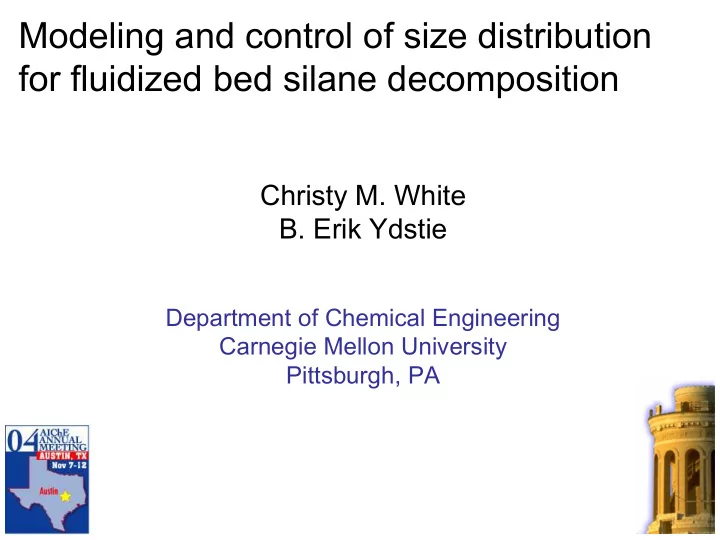

Modeling and control of size distribution for fluidized bed silane decomposition Christy M. White B. Erik Ydstie Department of Chemical Engineering Carnegie Mellon University Pittsburgh, PA
Photovoltaic Industry 1400 Installed Capacity Industry Growth (MW) IEA-PVPS, ‘03 0 1992 2002 Solar Cell Production Metallurgical Grade $3-5 per kg Electronic Grade $40-60 per kg SiHCl 3 (TCS) Decomposition Crystallization Raw Material Wafers IC’s Distillation Missing Link Insufficient Remelt/Cryst Wafers PV Cells Solar Grade Aim: $20 per kg 2
Silicon Production H 2 H H E E H H Si A A E E T T A A T T SiH 4 H 2 Si SiHCl 3 or SiH 4 Siemens Reactor Fluid Bed Reactor Dense Phase Batch Process Continuous Process SiH 4 Decomposition 1100°C 650°C Particle Growth Large surface area Size Distribution 3
Modeling Particulate Processes continuous distributed phase Crystallization phase Aerosol Formation Cell Growth Fluidization external coordinates space, time (mass balance) size, age, composition internal coordinates Population Balance density internal death and external distribution flux birth terms flow terms 4
Overall Reaction and Gas Phase Thermal Decomposition of Silane: Ideal operation: dense zone is a CSTR Gas phase balance equations (SiH 4 , H 2 ) Reaction rate defined by Lai et al. (1986) Accounting for loss through entrainment → Total reaction: η is fraction of product (powder) lost Behavior along external coordinate axes: position and time 5
Solid Phase fa n f i -1 f i Interval j Interval i Interval n … q i rxn i fa i,j Size interval mass balance Assume Derive f i assuming continuous number: can obtain: Behavior along internal coordinate axis: size 6
Solution Strategy for Discrete Model Ordinary differential equations for Algebraic constitutive + mass in gas and solid phases equations DAE system solved by MATLAB’s ode15s Adjustable Parameters Example Values Fraction of powder lost Aggregation proportionality constant 7
Experimental Data for Validation Si powder Operation of pilot scale reactor H 2 Load known initial distribution – sieves used to measure distribution Continuous feed to fluidized bed H H E E Withdraw samples regularly A A ~8-12 samples per run T T SiH 4 H 2 Si 8
Silicon in Reactor 9
Particle Size Distribution 10
Controlling Continuous Operation Si powder Objective H 2 control: mass of silicon manipulate: external flow rates System Si seed – Controller Si product SiH 4 H 2 feed 11
Inventory Control of Population Balance Apply inventory control to system: Constant mass in reactor: Constant seed mass: 12
Response to Set Point Changes 13
System Dynamics 14
Silicon Size Distribution 15
Summary • Size interval mass balance predictions of particle distribution compare well with data • Simulations of continuous operation and inventory control indicate that size is controllable • Further investigate measurability and stability • Application to other particulate processes or multi- scale modeling is significant 16
Acknowledgements • NSF Graduate Research Fellowship Program • Solar Grade Silicon LLC • Reactech Process Development Inc. • Ydstie Research Group Any opinions, findings, conclusions or recommendations expressed in this publication are those of the author(s) and do not necessarily reflect the views of the National Science Foundation 17
Recommend
More recommend